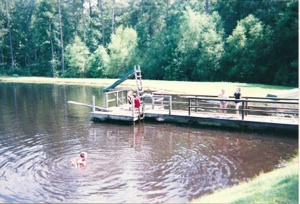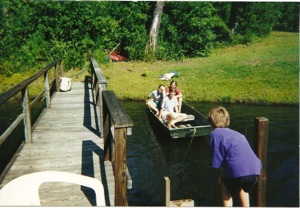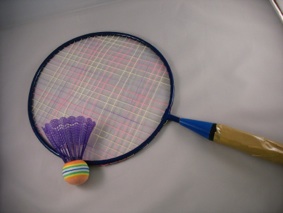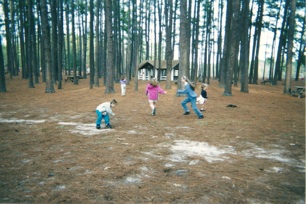Use the Summer Olympics to Motivate Your Kids to Exercise
Long Distance Running
After your kids have watched races, they may be much more open to the idea of running, especially if you set the example. Organize a neighborhood run, then train with your child to get her ready. It can give your child a huge sense of accomplishment to see that they can endure through a hard time, and succeed. It might even set them on a course of life long exercise. If they get excited about it, keep training, and see if there are local events to join, or sign up for track or cross country when they reach middle school. Eventually, you might even run a half marathon together! My daughter was SO proud of herself when she ran a half marathon!!
Broad Jump
Use a backyard sandbox, or a sandbox at a neighborhood park, or the sand at the beach if you go on vacation (or are lucky enough to live near one!!) Rake the sand smooth, then take turns running and jumping. Of course, grass or carpet work as well, they just don’t leave the tell tale signs of where the jumper landed! Use a measuring tape to see how far you jump. Remember to measure from what ever touches farthest back, so if your child falls backwards, the hands, not the feet, get measured. See if each person can improve their own distance after several tries.
Triathlon
If you have a body of water (pool or stream or pond) you can organize a triathlon. Take a trial run with one or more of your kids to determine a reasonable length for each leg of the competition so it is not too hard to achieve, but also not so easy that they don’t have to work hard to finish. Get other parents to help supervise so there is no concern for safety. Have at least 2 adults equipped with cell phones to escort each group of kids who go about the same speed.
Floor Exercises
After your kids have seen floor exercises, all they have to do is see a ball, hoop, or ribbon streamer, and they will pick them up and start playing around with them to try to imitate what they have seen. Make sure you have these lying around, and watch your kids start moving their bodies with no prompting at all. Turn on some music, and everyone can get moving (though they may need to take turns if space is limited.)
Cartwheels and Summersaults
Summersaults can be a challenge for young children, but they can master them with a little help. Older children like the challenge of learning to do a cartwheel. If you don’t know how to do it yourself, enlist a neighborhood teenager or friend to teach your kids. Once they can do a “bridge” (lie on their backs, then push their bodies up in the middle to form a bridge), they can try to stand up from this position--be sure to spot them so they don’t hurt themselves when they first attempt this. Once they can stand up this way, they can reverse the process to lean over backwards into a bridge. If they catch onto these simple moves quickly, they might enjoy gymnastic lessons. Our girls did.
Balance beam
Whether you put a two by four beam on the living room floor or in the backyard, kids will impulsively walk on it. Since it is on ground level, it is completely safe. Leave it around for awhile, and it can really improve their balance--it doesn’t have to be 4 feet off the ground to help them learn balance. Once they get good at walking forward, encourage them to walk backwards or sideways.
Swimming Races
If your only place to swim is in a crowded community pool, you may not be able organize swimming races. On the other hand, you might be able to organize all kinds of crazy races as kids see the fun you are having and ask to join in.
Water Polo
If the shallow end of the pool isn’t too crowded, you might be able to organize a game of polo. Do it where everyone can stand up so there are no safety issues. Check Wikipedia if you are not sure about the rules of the game.
Diving or Synchronized Swimming
Keep this silly and fun--no need to be olympians for this. Let each person come up with a dive or under water stunt, and let the others try to imitate him or her. The wackier, the better. Nose plugs will keep the “synchronized swimmers” from getting water up their noses while doing stunts. Make sure they all observe safety rules, especially to wait till swimmers get out of the way before diving!!
Cycling
It all depends on the ages and abilities of the contestants, as well as where you live, as to what these races might look like. If the children are young, and you live on a quiet street, you might be able to have races down the block. If you have older kids, and a bike rack or truck, you can transport them to a park--a safer location for longer races. Of course it can simply be a bike hike--it doesn’t have to be a race to benefit from the fun and exercise with a bunch of friends.
Rowing
This will take a lot more preparation, but might be a novel activity. Look for a friend who owns a rowboat or canoe, and a pond or stream to row it on, and would be willing to let your family use them. Insist that your kids wear life vests no matter how good they are at swimming. See if your friend will teach them some rowing techniques and tips before you get started. If you don’t have any such friends, see if nearby parks have boats or canoes to rent. Educate yourselves by reading how-to books or videos before you head to the lake.
Sprints, Hurdles, Relays
Whether you organize neighborhood kids, church kids, or just the family, keep these races light and fun. Remember that the goal here is to make them want to exercise, not to make them into olympians!! Be creative and make up new crazy races if you want--anything to get them running. Of course, if any of them excel at running, they might really get hooked on it!! Post people at the goal line to hold a streamer for the winner to break through. If there is time, re-string the streamer for each runner.
Field Hockey
This is usually considered a girls’ sport in the U.S., but there are men’s teams in India and other countries. If you don’t have the sticks, balls, and shin guards, it will be hard to come up with a way to play without investing in some equipment. If you have friends with the equipment, or if there is a school or community center that would be willing to rent the equipment, you can try out the sport before you spend money on the equipment.
Basketball
Although not quite as universal as soccer, If you have a basketball hoop in your driveway, you can play basketball as a family, or you can invite friends over and let them play--you don’t have to have 5 players on each team--you can play with as few as one player on each team. If you don’t, you might be able to find a community center that allows people to join or use the facility. If you are fuzzy on the rules of the game, look them up on Wikipedia. “Horse” is the name of the game you play with only 2 or 3 players.
Soccer
If you have a nice big yard and a soccer ball, it is pretty easy to start a soccer game. As soon as other kids see you playing, they will want to join in the fun. If not, transport balls and kids to a nearby park or playground where there is a field. Since this is such a universal sport that only requires a ball, I highly recommend teaching your kids to play. It will enable your children to easily join groups of playing children where ever they go.
Beach Volley Ball
All you need is a net and ball. A beach ball, rubber ball or real volley ball can be used. Save the real volley ball for older children, because it can really hurt to hit it with your hands, even for adults! Setting up a net can be a bit tricky, but if you are creative, there are many ways to make a net. If you have 2 anchor points that won’t fall over with some tugging (trees, poles, windows, swing set, jungle gym, or basketball goal), you can tie a rope between the two points to represent the net. If you want it to look more like a net, tape newspapers, clear plastic bags, or netting to the rope. The net shown here was purchased at a toy store. It is a set that also makes a soccer goal, tennis net, hockey goal, and basket ball goal. Check out Wikipedia for rules of the game if you are unsure how to play the game.
Tennis
You need tennis rackets, balls, and a net. Balls are not very expensive, so buy new ones, but borrow tennis rackets, or buy them at a garage sale until you know if your kids like the sport. Some community centers have courts that are available for free. If not, it should be fairly easy to find a court if you don’t mind paying for it’s use. If you have a large wall next to a driveway, your kids can practice hitting a ball against the wall. This is not nearly as fun as playing with another person, so don’t expect their interest to blossom if this is all they do. If you have a large yard, you can use trash cans or lawn chairs to represent a net, though it may be hard to get the balls to bounce on the grass. If you have a small yard, there are tennis balls that are fastened to an elastic string and heavy base that will keep the balls from going into the neighbors’ yards (in Japan, anyway.) Tennis is a sport that they can play for a life time, so this may be a good sport to invest time in to help them get good enough to enjoy it long term as a fun way to exercise.
Badminton or Ping-pong
Both of these sports require special equipment, but they are not very expensive (except for a ping-pong table.) If you just want to try it out to see if your children enjoy them, you might want to consider borrowing the equipment from a friend. You can use a dining room table as a ping-pong table, although it will be quite a bit narrower than a ping-pong table. For ideas for a badminton net, see the Beach Volley Ball paragraph.
Kids learn so much through imitating, so watching the Olympics can create a great atmosphere to get them excited about exercising. Strike while the iron is hot--as soon as they see an event, organize an activity that enables them to do something similar to what they saw. Your goal is to get them enthusiastic about exercising, not to make them olympians, so keep it light and fun. Make sure it is something they can do--it is discouraging to be expected to do something that is developmentally impossible!! Most 7 and 8 year olds can’t dribble a ball, so don’t expect a 3 or 4 year old to be able to!! On the other hand, they get a huge boost to their self confidence when they have worked hard to accomplish a difficult task, and succeed. As parents, that is a really precarious line to walk--creating opportunities for your kids that are not too hard or too easy. Don’t worry if you don’t get it right every time--if the challenge is too easy, they will get bored, and you can make the next activity tougher. If it’s a little too tough, they can learn perseverance--not a bad lesson to prepare them for life!! Just pay close attention to what they do well, and what they enjoy--help them succeed where they excel. You could sign them up for lessons so they learn from someone who knows what they are doing, or sign them up for a team so they gain experience in that sport.
Track and Field
Gymnastics
Swimming
Big Events
Team Sports
Sports in Pairs


















Family Fun > Use Summer Olympics to Motivate Your Kids to Exercise
Family Fun > Use Summer Olympics to Motivate Your Kids to Exercise



